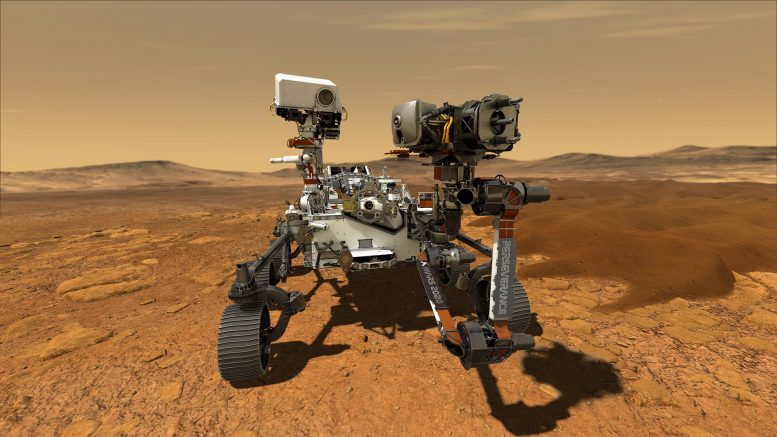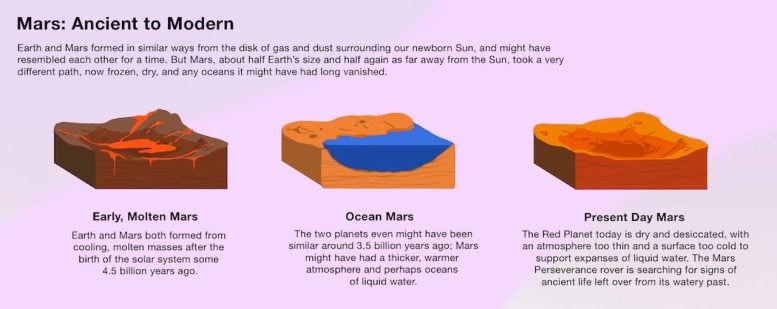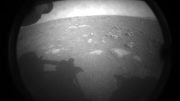
Poised against the stark, red landscape of Mars, the Perseverance rover embodies humanity’s unyielding curiosity. Its intricate array of tools and scientific instruments, meticulously designed for probing and analyzing, make it more than a mere machine. As it ventures into ancient craters and surveys rock formations, Perseverance carries on a quest that transcends our time – the search for signs of life beyond Earth. Every sample collected, every image captured, builds upon our understanding of the universe and our place within it. Credit: NASA/JPL-Caltech
NASA’s search for life on Mars, driven by the Perseverance rover, may soon yield promising results. Past endeavors, while not definitively proving life, have informed current investigation techniques and broadened our understanding of non-biological processes that can mimic life, bolstering future exploration of habitable places across the solar system, including icy moons of Saturn and Jupiter.
While Mars seems to be a promising nearby place to search for life beyond Earth, the Red Planet has held on stubbornly to its secrets. Despite decades of investigation – and even two initially exciting results – sure signs of life have yet to emerge.
Now this long search could be on the cusp of bearing fruit. The Perseverance rover has been scouring an ancient Martian crater, once filled with water, for evidence of past life, and caching samples of rock and surface material in metal tubes for eventual return to Earth.
And those past exciting results, though now considered to have fallen short of proving life ever thrived on our neighboring planet, are seen as an essential foundation to the focused, multi-layered search that is underway today.
“Previous missions have helped us understand better how to search for life,” said Lindsay Hays, deputy program scientist for the Astrobiology Program – studying the possibility of life beyond Earth – at NASA Headquarters in Washington, and the deputy lead scientist for the Mars Sample Return mission.
The in-depth exploration of Mars also will serve as a proving ground for the broader search to come: surveying ice-covered moons in the outer solar system for some sign of life in the vast oceans hidden beneath their surfaces.
“NASA has invested a lot in the search for life on Mars, and learned a lot that is going to help us as we look at other habitable places in the solar system – like the icy moons orbiting Saturn and Jupiter,” said Mary Voytek, director of the NASA Astrobiology Program at the agency’s headquarters in Washington.

The Jezero Crater on Mars as it might have looked billions of years ago, when it was a crater-lake with a river delta, is shown in this illustration. Credit: NASA/JPL-Caltech/Lizbeth B. De La Torre
Searching in Mars Rocks
To find the roots of NASA’s strategy in the search for life among our neighboring worlds, we might look back to the 1970s: the days of Carl Sagan and the twin Viking landers, which made history when both touched down on Mars in 1976.
Sagan, host of the original “Cosmos” television series, helped design and manage Viking 1 and Viking 2, which transmitted photos and gathered science data from the Martian surface. They also conducted life detection experiments, collecting samples of Martian surface material, called regolith, and adding nutrients. Despite signs that some nutrients were being consumed, most of the scientific community concluded this was likely due to non-biological reactions, dousing an initial spark of excitement over the possible discovery of life on Mars.
A second big moment came in 1996, when NASA scientists published a paper outlining possible chemical traces of life-forms in a Martian rock that fell to Earth. Known colloquially as the Allan Hills meteorite, or by its official number, ALH84001, it had been collected in Antarctica more than a decade earlier.
While meteorites from Mars have fallen to Earth regularly over the history of the two planets – likely blasted into space when large objects like asteroids slammed into the Red Planet, then eventually being captured by Earth’s gravitational field – this one seemed special. It contained chemical traces similar to those left behind by Earth microbes; some photographs even revealed microscopic features that looked something like bacteria. Once again, however, a global thrill of potential discovery subsided into uncertainty. Today, most scientists who have studied this question consider a non-biological source as the likely origin of the “evidence” for traces of past Martian microbes in the meteorite.
The group of researchers who published the paper, led by NASA scientist David S. McKay, “sometimes have been sort of short-changed,” said Andrew Steele, a Carnegie Institution staff scientist who also has investigated the Martian rock. “The actual impact they had on this science should be celebrated more, for taking the chances they did. It’s what led us to being able to ask the next set of really important questions.”
The team’s findings spurred further research and highlighted a new realization: Many non-biological processes could produce lifelike features.
Steele’s own work, for example, aims to set a background level for “no life present” for environments on other worlds, including Mars. Potential life-detection results then could be measured against this background. Building on the work of McKay’s group and others, Steele and his fellow researchers have found three separate chemical processes that could produce life’s building blocks on Mars – each synthesizing organic molecules in the absence of any biological activity.
“Mars is exciting, and still may have signs of life,” he said. “But it is also teaching us about how the building blocks of life can form.”
And those two early attempts to find Martian life also led to another major revelation: The search would have to be comprehensive, not “grab and go,” said Hays, the astrobiologist.
“Both of those interpretations of results were inhibited by a lack of context,” Hays said. “In the case of the Viking, a lack of context about the measurements they were going to be making – what they could tell us about the environment we were measuring them in. In the case of Allan Hills [the Martian meteorite], a lack of context about the environment those rocks came from.”
Looking for Life on Mars
To move the investigation forward, NASA first decided not to take direct aim at detecting life itself. Instead, the twin rovers Spirit and Opportunity took a detailed survey of the Martian environment, confirming habitable conditions on early Mars in part through geological evidence of flowing water. Mars orbiters, such as NASA’s Mars Reconnaissance Orbiter and Mars Odyssey, also played a role, helping map terrain and select landing sites.
The Mars Curiosity rover made the case for habitability even stronger, capturing evidence of abundant water, organic molecules and habitable environments in Mars’ distant past. The rover continues its work today in Gale Crater, where it is still finding evidence of water activity in the past.
NASA turned back to the business of life detection with the arrival of the Perseverance rover at Jezero Crater in February 2021. Once a lake, complete with a river delta, Jezero seemed an ideal spot to search for life signs from Mars’ distant past.
But unlike the Viking landers, Perseverance is equipped with an array of tools both to examine Martian rocks for signs of ancient life and to explore their environmental context.
Also unlike Viking, the rovers can move. Perseverance targets interesting rock formations from a distance – with help from its helicopter scout, Ingenuity – then drives there for a closer look.
That also means Perseverance, which is caching samples that will later be returned to Earth, has an advantage over past investigations that lacked context for what they were finding. “This well-equipped rover is getting all this context as it’s making all those great measurements,” Hays said.
Other possible future places to look for signs of life include sites where water collected underground on ancient Mars, once forming a system of subsurface lakes.
Searching for Life Elsewhere in the Solar System
Little is known about the deep, ice-encased oceans of the solar system’s outer moons, such as the Jupiter moon Europa and Saturn’s Enceladus and Titan. But one thing is already clear: They’ll offer vastly different conditions for potential life than Mars.
Still, these watery, sunless environments might have recognizable organic material and associated chemistry, and even a heat source – the moons’ internal heat, perhaps released through vents in ocean floors. It’s one way life might have started on Earth.
During a 13-year mission that ended in 2017, NASA’s Cassini spacecraft detected plumes of salty water and organic molecules spewing from fractures known as “tiger stripes” on Enceladus – possibly from the moon’s subsurface ocean, suggesting a potentially habitable environment.
Europa might have similar plumes: Data from NASA’s Galileo spacecraft and Hubble telescope, as well as Earth-based telescopes, has hinted at their presence. NASA’s Europa Clipper spacecraft, now being assembled for possible launch in October 2024, will carry sensors capable of analyzing any plume material it might encounter in a series of flybys past the ice-encrusted moon.
And Saturn’s Titan, though best known for its thick hydrocarbon atmosphere and lakes of ethane and methane, is likely an ocean world as well – like the others, concealing a deep, liquid-water ocean beneath an icy shell. If the subsurface somehow makes contact with the surface – now or in the past – evidence of molecules or chemistry suggesting the potential for life might be found there. NASA’s Dragonfly mission, a rotor-driven flier, will search for such evidence in a mission planned for the mid-2030s.
Although the Martian and outer moon environments are vastly different, the principles of searching for life remain the same.
“What we’ve learned about life on Earth is, as long as there are some basic things like nutrients, water, and energy, we’re going to find life,” Voytek said. “And we believe that many environments within the solar system meet these requirements. But they have yet to be explored.”
Search for Life
- Part 1: Beginnings: Life on Our World and Others
- Part 2: Life on Other Planets: What Is Life and What Does It Need?
- Part 3: The Hunt for Life on Mars and Elsewhere in the Solar System
- Part 4: Unraveling the Cosmic Origins of Life in the Lab










If one would like to submit a manuscript for publication on this blog, who would they contact?
Pat Brennen’s article is very interesting. However, I would like to make one correction to his blog. Although NASA hasn’t admitted to finding life on the Planet Mars, it has already shown that it exists in its selfie photographs taken by the Mars Rover Perseverance. And the same kind of life forms can be seen in the photograph growing of the strand of string that supposedly was from one of the coverings that NASA use to cover Perseverance when it was sent to Mars. Either the life forms represent contaminates from Earth or they are of Martian origin. I believe the latter.